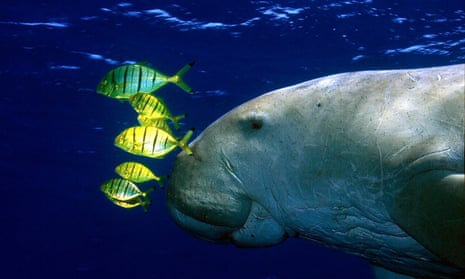The dugong is now functionally extinct in China after widespread degradation of their habitat and historical hunting, scientists have said.
Fishing and ship strikes are also among the reasons dugong activity has declined, said Prof Samuel Turvey of ZSL’s Institute of Zoology, who described the findings as a “wake-up call” to prioritise conservation efforts.
Since 1988, the dugong has been classified by the Chinese state council as a grade one national key protected animal, which affords it the highest level of protection. However, there are no records of the dugong’s presence in China since 2008.
“Our new study shows strong evidence of the regional loss of another charismatic aquatic mammal species in China – sadly, once again driven by unsustainable human activity,” said Turvey, one of the authors of the research published in the Royal Society Open Science journal.
The dugongs are particularly dependent on seagrass, a specific marine habitat that is being rapidly degraded by human impacts from coastal development to water pollution.
Turvey said seagrass beds were also vulnerable to a process called “eutrophication” – where algal blooms form due to human-caused increases of nutrients in the water, such as from sewage. This “decreases the ability of light to penetrate through seawater and thus prevents seagrass photosynthesis,” Turvey said.
Although seagrass restoration and recovery efforts are considered a key conservation priority in China, the restoration process can be lengthy and it may already be too late for the dugong populations residing there.
Dr Heidi Ma, a postdoctoral researcher at ZSL’s Institute of Zoology and also an author of the study, said the researchers conducted interview surveys across four southern maritime provinces along the coastal region of the South China Sea to collect local knowledge about dugong sightings and their regional status.
Using interview surveys from local residents “demonstrates the usefulness of ecological knowledge for understanding species’ status, but also helps us engage local communities and to investigate possible drivers of wildlife decline and potential solutions for mitigation”, Ma said.
The researchers also reviewed historical data covering past dugong distribution and activity in China.
after newsletter promotion
The authors of the study said they would “welcome any possible future evidence” that dugongs might still persevere in China – however, their research shows no recent evidence of dugong survival across their known homes in mainland Chinese waters.
Outside China, dugong populations can be found in tropical and sub-tropical coastal waters from Vanuatu to the south-western islands of Japan. They are globally threatened and listed as vulnerable by the International Union for Conservation of Nature.
The new research is “a sobering reminder that extinctions can occur before effective conservation actions are developed,” Turvey said.
